A hybrid acoustic metamaterial for low-frequency constant nearly perfect sound absorption with large deformation
IF 3.4
2区 物理与天体物理
Q1 ACOUSTICS
引用次数: 0
Abstract
The sound absorption capacity of cavity-based absorbers is inevitably severely affected by structural deformation due to external loads, and dynamic tunability of the absorption frequency cannot be achieved once fabrication is complete. In this work, a novel compressible hybrid metamaterial for low-frequency constant sound absorption is proposed, which ingeniously combines the characteristics of origami-inspired V-shaped and helical structures, integrating a Helmholtz resonator with two extended necks and a micro-perforated panel resonator. The metamaterial is manufactured using 3D printing technology. Experimental and analytical results demonstrate that the nearly perfect sound absorption is constantly maintained at 315 Hz no matter how the absorber deforms, while the second absorption peak can be tuned from 509 Hz to 682 Hz with a compression strain range of 0 % to 31.3 %. The absorber also exhibits excellent absorption at oblique incidence angles up to 60°, both before and after deformation. Moreover, by employing a coupled unit strategy the low-frequency absorption bandwidth can be broadened, while maintaining stability within the range of 316–391 Hz during structural deformation. This design strategy provides a promising approach for enabling adaptive sound absorption and multifunctional metamaterials, opening up new possibilities for tunable noise control applications.

求助全文
约1分钟内获得全文
求助全文
来源期刊

Applied Acoustics
物理-声学
CiteScore
7.40
自引率
11.80%
发文量
618
审稿时长
7.5 months
期刊介绍:
Since its launch in 1968, Applied Acoustics has been publishing high quality research papers providing state-of-the-art coverage of research findings for engineers and scientists involved in applications of acoustics in the widest sense.
Applied Acoustics looks not only at recent developments in the understanding of acoustics but also at ways of exploiting that understanding. The Journal aims to encourage the exchange of practical experience through publication and in so doing creates a fund of technological information that can be used for solving related problems. The presentation of information in graphical or tabular form is especially encouraged. If a report of a mathematical development is a necessary part of a paper it is important to ensure that it is there only as an integral part of a practical solution to a problem and is supported by data. Applied Acoustics encourages the exchange of practical experience in the following ways: • Complete Papers • Short Technical Notes • Review Articles; and thereby provides a wealth of technological information that can be used to solve related problems.
Manuscripts that address all fields of applications of acoustics ranging from medicine and NDT to the environment and buildings are welcome.
 求助内容:
求助内容: 应助结果提醒方式:
应助结果提醒方式:


